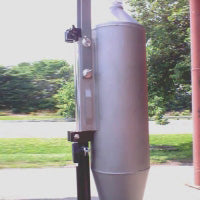Cotton dust is sampled into the vertical elutriator at a flow rate of 7.4 lpm. The entrance to the elutriator is at a height of ~ 4½ to 5½ feet (1.4 to 1.7 m), within the breathing zone. The elutriator separates the large cotton lint particles from the smaller, inhalable cotton dust particles. The cotton dust is collected on a 37mm diameter polyvinylchloride (PVC) membrane filter in a quick-removable, three-piece plastic cassette. The sealable filter cassette facilitates ease of storage and transportation.
The 37mm filter is weighed before and after sampling in a controlled environment. The increase in weight is the mass of the sampled cotton dust. The mass concentration of cotton dust (micrograms per m3) is the collected mass (micrograms) of cotton dust divided by the sampled air volume (m3). Tubing carries the airflow from the filter cassette to the critical orifice flow regulator and the vacuum pump.
The cotton dust enters the inlet of the elutriator at 7.4 lpm. The separation chamber of the elutriator has an inside diameter of 6-inches (15 cm) and a length of 14-inches (35.6 cm). The 7.4 lpm flow rate and the 6-inch (15 cm) I.D. yield an upward air flow velocity in the separation chamber equal to the sedimentation velocity of a particle with an aerodynamic diameter of 15 microns. Thus, cotton lint particles larger than 15 microns settle out and are not carried into the 37mm diameter filter, but inhalable cotton dust smaller than 15 microns is collected by the filter.
Cotton dust is dust present in the air during the handling or processing of cotton in the textile industry as well as several other industries. This dust may contain a mixture of many substances including ground up plant matter, fiber, bacteria, fungi, soil, pesticides, non-cotton matter and other contaminants.
Exposure to cotton dust can cause serious health problems. The first symptoms of disease are difficulty in breathing or perhaps a tightness across the chest. Workers can also cough up phlegm or mucous. If exposure continues, byssinosis, also known as “brown lung” disease may develop. While earlier breathing difficulties may be reversible, damage at the advanced stages of the disease is permanent and disabling. Exposure to cotton dust also leads to increased risk of chronic bronchitis and emphysema.
To protect workers from disabling respiratory diseases, employees are required to limit the amount of respirable cotton dust in the air. The limits – known as permissible exposure limits – are average exposures over an eight-hour workday. A typical limit for yarn manufacturing is 200 µg of cotton dust per cubic meter of air; for textile waste houses - 500 µg; for slashing and weaving operations - 750 µg; and for waste recycling and garnetting – 1000 µg.
Employees must measure the workplace cotton dust level at least every six months, or whenever there are changes in equipment or work practices that might increase the amount of cotton dust in the air. The cotton dust must be measured with a vertical elutriator or an equivalent instrument. Measurements must be representative of an eight-hour period and be performed for each shift and in each work area.
Design
The Series NS-4000 Cotton Dust Sampler is mounted on the columns or walls of the work place (alternatively a tripod stand is available). The sampler is packaged for convenience and portability. The NS-4000 consists of the Lumsden-Lynch vertical elutriator, a three-piece plastic 37mm filter cassette, critical orifice for regulating the flow rate at 7.4 ± 0.2 lpm, low maintenance vacuum pump with mounting brackets, 0 to 30” Hg vacuum gauge, tubing, fittings and filter jar.
Features
Meets all OSHA cotton dust regulations
Specifications
| Particle Cut-Point |
15μ @ 7.4 lpm |
| Filter Cassette |
Plastic (polystyrene); for 37mm membrane filter with back-up pad; three-piece design |
| Filter Media |
Polyvinylchloride (PVC) filter media with 5-micron pore size, 37mm diameter |
| Vacuum Pump |
Oil-Less Rotary Vane, 1/10 HP, 1.25 cfm (35 lpm) free-flow; weight: 8 lbs. (3.6 kg) |
| Vertical Elutriator |
Over-all dimensions - 6-inch (15 cm) O.D. x 28-inch (71 cm) L; weight: 7.25 lbs. (3.3 kg) |
| Power |
115VAC, 50-60Hz or 230VAC, 50-60Hz |
| Net Weight / Shipping Weight |
20 lbs. (9 kg) / 39 lbs. (17 kg) |

